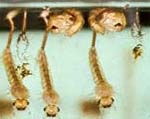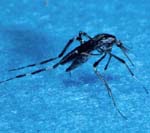Mosquitoes
Culicidae
Description

Figure 1. Culex pipiens
Mosquito Larvae
Adult mosquitoes are small, usually about 1/4 inch long, slender-bodied biting flies. Their wings are long, slender, and hairy, particularly along the veins. Some mosquitoes, such as Psorophora, are larger, about 1/2 inch long. Adults lay elongate eggs that are about 1/40 inch long, and dark-brown or black when ready to hatch. The eggs are laid in batches of 50 to 200, either separately or glued together in small clusters. Eggs hatch into elongate, legless, larvae with a large head with mouth brushes and a short tube (siphon) at the posterior end. Fully grown larvae are usually 1/4 to 3/8 inch long depending on the species. They change into pupae that are comma-shaped.
Life History
Depending on the species, mosquitoes may overwinter as eggs, fertilized adult females, or larvae. Adult males feed on flower nectar. Only adult female mosquitoes bite and feed on blood which is used to produce eggs. The eggs are laid near or in water and hatch into larvae that live in water, usually at or near the surface. Most larvae feed on bits of suspended organic debris, using their mouth brushes to strain the food out of the water. The larvae quickly wiggle to the bottom when disturbed, and thus are commonly called wrigglers.
Larvae live for about a week and then change into pupae which also live at or near the water surface. Pupae do not feed but are active, diving end over end to the bottom if disturbed, and are therefore, called tumblers. After a 2 or 3 day pupal stage, adult mosquitoes emerge onto the water surface. Adults are light enough to stand on the surface film. Once they have dried and hardened from their emergence, they fly to grass, shrubbery, or other foliage. Mating occurs within the next day or two and then females start to search for blood meals. Associated with their egg-laying habits, species tend be either floodwater or container-breeding mosquitoes.
Floodwater Mosquitoes
These mosquitoes lay their eggs on low-lying dry ground that is later flooded by rainfall. Heavy rains may cause enough flooding that large numbers of eggs hatch that were laid over the previous two or more years. Under normal summer temperatures, large numbers of biting mosquitoes will emerge about two weeks after heavy rains and can be a major nuisance problem for one to two weeks. The most common floodwater mosquito in Illinois is the inland floodwater mosquito, Aedes vexans. This insect is a vicious biter that will commonly fly ten or more miles from flooded areas, particularly along prevailing winds. Psorophora are less common but very large mosquitoes that readily bite people. Floodwater mosquitoes are not major vectors of human disease in Illinois, but Aedes vexans does transmit dog heartworm.
Container-breeding Mosquitoes
These mosquitoes lay their eggs in stagnant water in treeholes, old tires, clogged gutters, old tin cans, and anything else that will hold water. The presence of organic matter such as fallen leaves and grass clippings make the water even more attractive for egg-laying. Eggs are laid on or just above the water surface. The eggs will usually hatch within 2 or 3 days after they are laid. One of the more common container-breeding mosquitoes in Illinois is the northern house mosquito, Culex pipiens. Although it can travel long distances, it usually will migrate much less than a mile. It is the common vector of St. Louis encephalitis and also transmits dog heartworm in Illinois. Another mosquito that usually does not fly long distances is the eastern treehole mosquito, Aedes triseriatus. It is usually associated with forested areas and is the main vector of LaCrosse (California) encephalitis in the state.The Asian tiger mosquito, Aedes albopictus, is a recently introduced mosquito to Illinois. It is one of the few day-biting mosquitoes in Illinois, and will breed in large numbers in residential areas. This 1/4 inch long black mosquito is a vicious biter. It has a white stripe down the middle of the head and back and has white-banded legs. It transmits dengue fever in other parts of the world, and has the potential of becoming an important vector of LaCrosse and possibly St. Louis encephalitis in Illinois.

Figure 2. Mosquito
Development Site
Reduce the number of mosquito breeding sites outdoors by eliminating containers that will hold water such as old tires and tin cans. Keep eave troughs clean of fallen leaves and other debris so that rainwater drains readily. Empty and clean bird baths, pet watering bowls, and children's wading pools weekly. Abandoned swimming pools should be kept covered to prevent rainwater accumulation. Backyard lily ponds and other areas that hold water throughout the summer can be stocked with fish from a local bait shop to eliminate mosquito larvae. Most ponds and lakes are not a major source of mosquitoes because resident fish populations eat the larvae.
Keep screens on windows and doors in good repair.
Avoid going outdoors at or shortly after dark or into forested and other areas where mosquitoes are numerous during floodwater mosquito outbreaks or encephalitis warnings. Mosquitoes are attracted to persons who are wearing dark clothing and perspiring. Some individuals are inherently more attractive to mosquitoes than others, apparently related to chemical constituents of the blood and vapors given off through the skin.

Figure 3. Adult Mosquito
Use a repellent when entering mosquito-infested areas. There are several commercially-available repellents that may be used on clothing or exposed skin to provide protection.
Spraying grass, shrubs, and other vegetation with an insecticide can reduce mosquitoes for a few hours to a couple of days. This may be useful prior to wedding receptions, parties, or other occasional evening outdoor events.
There are some popularly touted mosquito control methods that are not very effective. Bug zappers are not effective in controlling biting mosquitoes. Their light will actually attract biting mosquitoes, but then they search for a blood meal rather than fly into the trap. Various birds and bats will eat large numbers of mosquitoes when they are very numerous, but will tend to ignore them when few in number, preferring larger insects such as moths. Some plants have mosquito repelling properties, but are effective for only a small area around them.
Community wide mosquito control programs can be quite effective if they are conducted as an integrated pest management (IPM) program. This includes monitoring and draining or treating mosquito breeding habitat such as occasionally flooded marshes, river backwater areas, swamps, and other low-lying areas, controlling larval populations with insecticides and biological control agents, and occasional fogging of adult mosquito outbreaks based on light trap collections or mosquito landing counts.
Suggested repellents and insecticides for the control of mosquito problems are published annually in Insect Pest Management for the Home, Yard, and Garden in the Illinois Urban Pest Control Handbook available through local Extension offices.